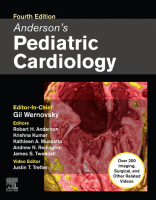Physical Address
304 North Cardinal St.
Dorchester Center, MA 02124

History of Classification of the Cardiomyopathies Cardiomyopathies are a heterogeneous group of diseases of the myocardium ( Box 61.1 ). They were initially described as “heart muscle disease of unknown cause” by the World Health Organization/International Society and Federation of…

Introduction Systemic hypertension remains one of the most common cardiovascular diseases in adults. Over the past decade, several publications have highlighted the increasing prevalence of hypertension in children and young people and its increasing public health importance, mirroring the increasing…

Cardiac involvement in systemic disease can broadly be divided into those conditions where the heart is involved in the disease process itself and those where a structural or functional cardiac abnormality is associated with other anomalies, usually in a recognizable…

Introduction The genetic basis for heart and vascular conditions is heterogeneous and includes both heritable and de novo mutations. More than 100 genes associated with congenital or progressive cardiovascular abnormalities have thus far been identified. In recent years there has…

The pericardium derives its name from the Greek term peri, meaning “around,” and kardia, meaning “heart.” It is composed of two layers. The inner layer (visceral pericardium) consists of a single layer of mesothelial cells, collagen, and elastin fibers separated…

Infective endocarditis (IE) is an infection of the endocardium, valves, or related structures of the heart and walls. It may arise following more frequent and prolonged bacteremia in a patient with or without a predisposing cardiac lesion. Infective endarteritis is…

Chronic rheumatic heart disease (RHD) is the persistence of valvar dysfunction following an episode of acute rheumatic fever (ARF) or ARF recurrence. Once the inflammatory markers normalize, any persistent valve dysfunction should be termed chronic RHD. Background and Epidemiology ARF,…

Introduction Rheumatic fever (RF) is an acute, diffuse, and nonsuppurative inflammatory disease that occurs as a delayed complication after an untreated or partially treated pharyngotonsillitis, the infection itself sometimes being asymptomatic. It is caused by group A β-hemolytic S treptococcus…

Kawasaki disease was first described in 1967 by Tomisako Kawasaki, a Japanese pediatrician. He characterized the illness, then termed mucocutaneous lymph node syndrome , as including high fever, nonexudative conjunctivitis, inflammation of the oral mucosa, rash, cervical adenopathy, and findings…

Cardiac tumors in infants and children are rare. Previously, their atypical clinical presentation prevented timely diagnosis, and the diagnosis was often postmortem. Currently, the widespread use of echocardiography and other noninvasive diagnostic imaging modalities has resulted in a marked increase…